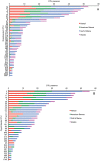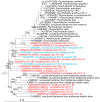Humpback whale populations share a core skin bacterial community: towards a health index for marine mammals?
- PMID: 24671052
- PMCID: PMC3966734
- DOI: 10.1371/journal.pone.0090785
Humpback whale populations share a core skin bacterial community: towards a health index for marine mammals?
Abstract
Microbes are now well regarded for their important role in mammalian health. The microbiology of skin--a unique interface between the host and environment--is a major research focus in human health and skin disorders, but is less explored in other mammals. Here, we report on a cross-population study of the skin-associated bacterial community of humpback whales (Megaptera novaeangliae), and examine the potential for a core bacterial community and its variability with host (endogenous) or geographic/environmental (exogenous) specific factors. Skin biopsies or freshly sloughed skin from 56 individuals were sampled from populations in the North Atlantic, North Pacific and South Pacific oceans and bacteria were characterized using 454 pyrosequencing of SSU rRNA genes. Phylogenetic and statistical analyses revealed the ubiquity and abundance of bacteria belonging to the Flavobacteria genus Tenacibaculum and the Gammaproteobacteria genus Psychrobacter across the whale populations. Scanning electron microscopy of skin indicated that microbial cells colonize the skin surface. Despite the ubiquity of Tenacibaculum and Psychrobater spp., the relative composition of the skin-bacterial community differed significantly by geographic area as well as metabolic state of the animals (feeding versus starving during migration and breeding), suggesting that both exogenous and endogenous factors may play a role in influencing the skin-bacteria. Further, characteristics of the skin bacterial community from these free-swimming individuals were assembled and compared to two entangled and three dead individuals, revealing a decrease in the central or core bacterial community members (Tenacibaculum and Psychrobater spp.), as well as the emergence of potential pathogens in the latter cases. This is the first discovery of a cross-population, shared skin bacterial community. This research suggests that the skin bacteria may be connected to humpback health and immunity and could possibly serve as a useful index for health and skin disorder monitoring of threatened and endangered marine mammals.
Conflict of interest statement
Figures








References
-
- Willing BP, Dicksved J, Halfvarson J, Andersson AF, Lucio M, et al. (2010) A pyrosequencing study in twins shows that gastrointestinal microbial profiles vary with inflammatory bowel disease phenotypes. Gastroenterology 139: 1844–1854.e1841. - PubMed
-
- Bowers RM, McCubbin IB, Hallar AG, Fierer N (2012) Seasonal variability in airborne bacterial communities at a high-elevation site. Atmospheric Environment 50: 41–49.
Publication types
MeSH terms
Substances
Associated data
LinkOut - more resources
Full Text Sources
Other Literature Sources
Miscellaneous

